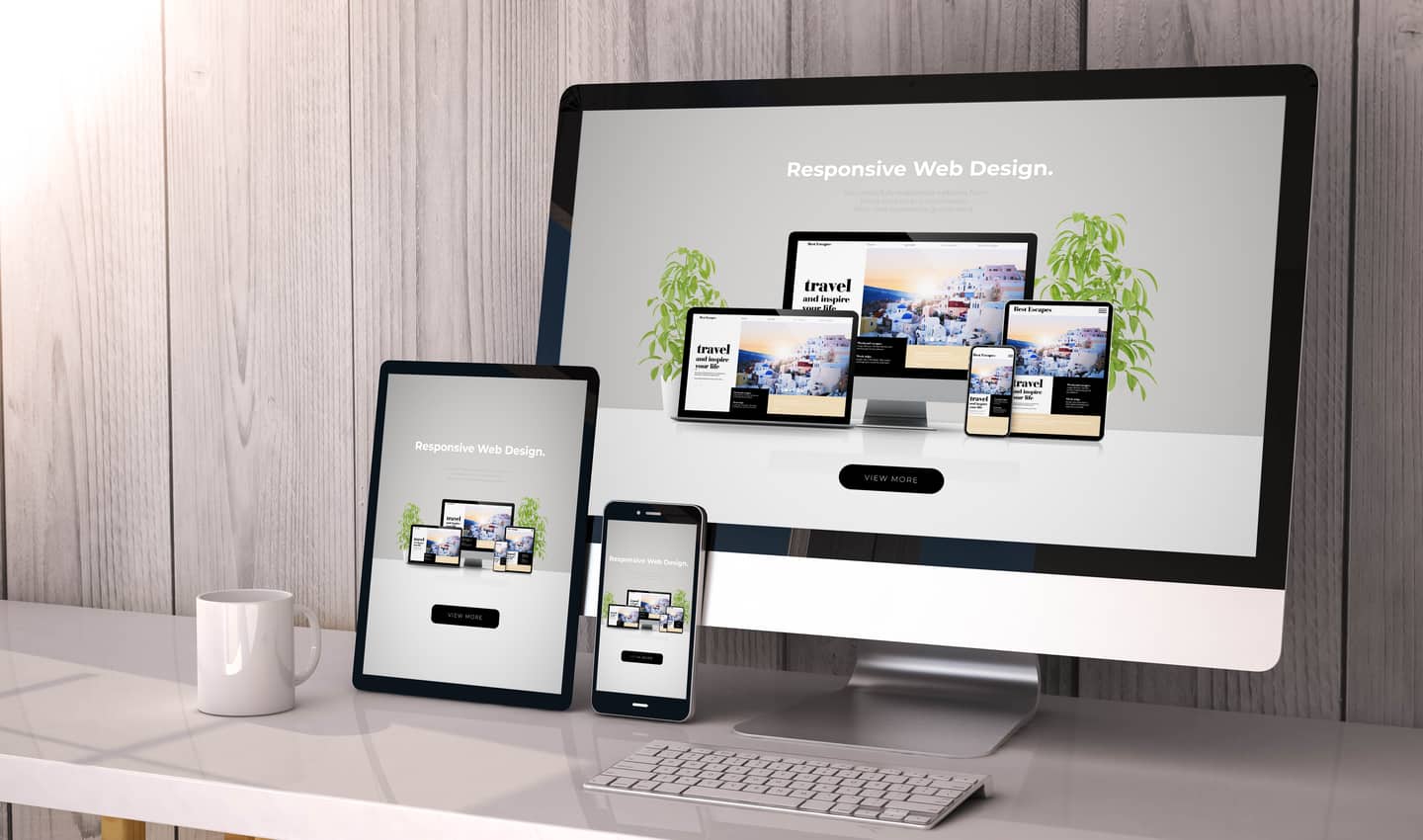How to Become a Freelance Web Designer in 7 Simple Steps
Our readers always come first
The content on DollarSprout includes links to our advertising partners. When you read our content and click on one of our partners’ links, and then decide to complete an offer — whether it’s downloading an app, opening an account, or some other action — we may earn a commission from that advertiser, at no extra cost to you.
Our ultimate goal is to educate and inform, not lure you into signing up for certain offers. Compensation from our partners may impact what products we cover and where they appear on the site, but does not have any impact on the objectivity of our reviews or advice.
To create an aesthetically pleasing, user-friendly website, many businesses and website owners use web designers. As a web designer, you'll use your creativity and eye for design to create quality websites and make sure that users have a great experience.

Our mission at DollarSprout is to help readers improve their financial lives, and we regularly partner with companies that share that same vision. If a purchase or signup is made through one of our Partners’ links, we may receive compensation for the referral. Learn more here.
According to Blue Corona, 38% of website visitors leave if they don’t like the layout or navigation.[1]
We’ve all clicked off of a website if the menu is hard to read or the content is impossible to find. I know I’ve done it.
People also evaluate a business’s credibility on the website’s appearance, and they expect it to load in two seconds or less. That means that websites need to look good, be user-friendly, and load quickly enough to keep visitors from moving on.
But how does a business achieve a functional, beautiful website that attracts and keeps users?
Among other things, they hire a web designer.
What is Web Design?
Web design is the appearance, layout, images, and other visual front-end elements that affect a user’s experience on a website. To create an aesthetically pleasing, user-friendly website, many businesses and website owners use web designers.
Web design vs. web development
While web design involves what users see when they go to a website, web developers work on the backend to make sure that the site functions properly.
This includes things like how fast the pages load, that users don’t experience errors, and making sure the website is mobile-friendly. Web developers typically use coding languages like HTML, CSS, and JavaScript to do their job.
Website owners might employ both a designer and developer to create a site for their business.
Related: 16 Online Business Ideas That Anyone Can Start
What Does a Web Designer Do and How Much Do They Make?
Web designers use their creativity and eye for design to create functional, user-friendly, and beautiful websites. They work in tandem with their clients to choose the site’s layout, colors, fonts, and images. They also make sure readers can easily navigate the site on a laptop, desktop, phone, or tablet.
Web designer qualifications
Web designers often have a degree or certificate in visual design. This isn’t a necessity, but it does help provide a fundamental understanding of website elements like color schemes, fonts, layouts, and proportions.
User Experience (UX) training is also helpful for potential web designers. This training helps designers think about different types of people who might use the site to help them map how each user will navigate it.
To implement the design and UX ideas, web designers often work with a programmer or learn coding languages like HTML (what gives the site structure) and CSS (what allows you to change colors, images, and other visual aspects). Learning these languages isn’t crucial for a web designer, but it can make you a better designer.
Average salary
According to Glassdoor, full-time corporate web designers make an average of about $52,000 per year. If you’d rather work for yourself, freelance web designers can make between $30 to $80 per hour.[2]
Related: 50 Freelance Job Websites to Find Your First (or Next) Gig
How to Start Working as a Website Designer

People who enjoy designing websites can build their own business with just a few simple steps. It may take time to grow a full-time income, but it is possible.
1. Enroll in a web design or development course
First, think about what skills you have and the ones you need. Then consider taking classes to bridge the gap. Udemy offers affordable classes on HTML and CSS, visual design, and user experience.
Online classes are practical and worthwhile if you’re trying to grow your web design skills. The cost for the courses is an investment that can pay off as you build your business.
The more skills and services you can offer, the more you can charge and the higher-profile clients you can work with. Plus, you can deduct the classes on your taxes.
2. Create your own business website
A great way to practice your design skills is to work on your first project: your own website. You can start by making a simple blog or website.
If you want to grow your web design business and attract clients, you need somewhere to showcase your skills and abilities. Your business site is your first and best advertisement to potential clients.
3. Add your portfolio to your website
Clients will hire you based on what they see, so it’s crucial that you showcase your design skills and personal projects on your business website. If you don’t have any clients, you can create mockup sites to demonstrate how you’d approach a particular design.
You can also reach out to local nonprofits, churches, or business-owner friends and offer to work on their site in exchange for testimonials.
4. Identify your ideal client
As you’re starting your business, you need to think about what your ideal client looks like. Ask yourself questions like:
- What type of business do they run?
- Is there a particular topic or genre you’d like to specialize in?
- Who runs the site you’re designing?
- How old are they?
- Where do they live?
- What is their budget?
This is just a sample list of questions. When creating your ideal client profile, you can add as many details as you want that will help you identify the types of sites that your ideal client owns and how to market and network with them.
5. Find clients
As a web designer, you’ll find work in one of two ways: working for someone else or freelancing. If you’re interested in freelancing, you’ll need to pitch clients as well.
Traditional web design jobs
Sometimes working for someone else is a great way to get your foot in the door and build your skills while earning a consistent paycheck. Some people prefer a traditional schedule and other perks of being an employee.
To find a job with a web design company, check out job postings on LinkedIn, Indeed, and Glassdoor. You can also do a search for “web design companies” and browse the careers section of their websites.
Make sure you have a solid resume, even if you don’t have much experience. Highlight things like your relevant training, testimonials from past clients, and the designs you’ve done.
Freelancing
As a freelancer, you’ll work for yourself. That means it’s your responsibility to manage your own schedule, track your income and expenses, and find clients.
One way to find clients is by networking. Figure out where your potential customers might be and visit those places. It can be a Facebook group, in-person meeting in your town, or even LinkedIn. Try networking with other freelance web designers; they may have some good tips for finding your first clients.
If networking with strangers is uncomfortable for you, you can start by designing a marketing campaign. Share your new services with your social media followers or email list, put together a Facebook ad campaign, or let your family and friends know what you’re doing.
Ask them if they can connect you with any potential clients. Sometimes that personal connection makes it a little easier to network.
Related: 25 Legitimate Ways to Earn Money Online
Pitching
Once you’re in front of potential clients, you’ll need to pitch them. Include a description of how you can help them, what makes you different, why they should hire you, and a brief summary of your experience or skills.
If you’re at a networking event, try to distill all of that information into a 60-second “elevator pitch,” and make sure you have some business cards on hand to distribute so potential clients have a way to contact you. You can even use your cards as a small sample of your work.
6. Promote your services
To grow their business, freelance web designers need to promote themselves and their services.
Social media is a free and effective way to generate interest in your design skills, and it’s also a way to stay connected to your network. Using free platforms like Facebook, Twitter, and Instagram, you can share updates on your projects, your menu of services, and even ask your followers what they’d like you to learn or work on.
Sponsored or targeted ads on social media networks are another effective method for driving traffic to your design services. This expands your potential client base as you have the ability to reach clients beyond your local area.
If you have an email list, you can use that to share design tips and tricks, give inside information on upcoming projects or updates, or even offer discounts for new customers.
Related: How to Become a Graphic Designer in 8 Simple Steps
7. Build your brand
As a web designer, you’ll help companies build their brand. But it’s equally important that you build your personal brand as well. There are a few ways you can do this:
Your website. Create and update your website to reflect your personality. Make sure that you’re conveying the right feeling to your ideal customer.
Your social media. Be consistent across all platforms. Use the same name, profile picture, tone (e.g., casual vs. professional), and website information everywhere you share your business details. People will get to know you this way.
Your niche. Focus on a particular niche, ideally one you’re passionate about. It’s easier to market to a specific audience than to everyone. Who knows, you could become the go-to person for healthy recipe websites or handmade soap makers.
Your services. Work well with your clients. A happy customer will refer you to friends or family who need your services, and reviews from satisfied customers are the easiest way to build your brand.
Creating a solid, consistent brand builds trust, recognition, and makes potential clients more likely to hire you.
Should You Become a Website Designer?
If you’re creative, good at design, and have basic coding skills (or are willing to learn them), you might do well working in website design. You also need to be able to listen to your clients, work collaboratively with them and web developers, and, if you’re interested in freelancing, be able to market and pitch yourself.
Although breaking into the field can be difficult, especially for those without any specialized training, if you practice, network, and look for opportunities to develop your skills and portfolio, you can find success as a web designer.







